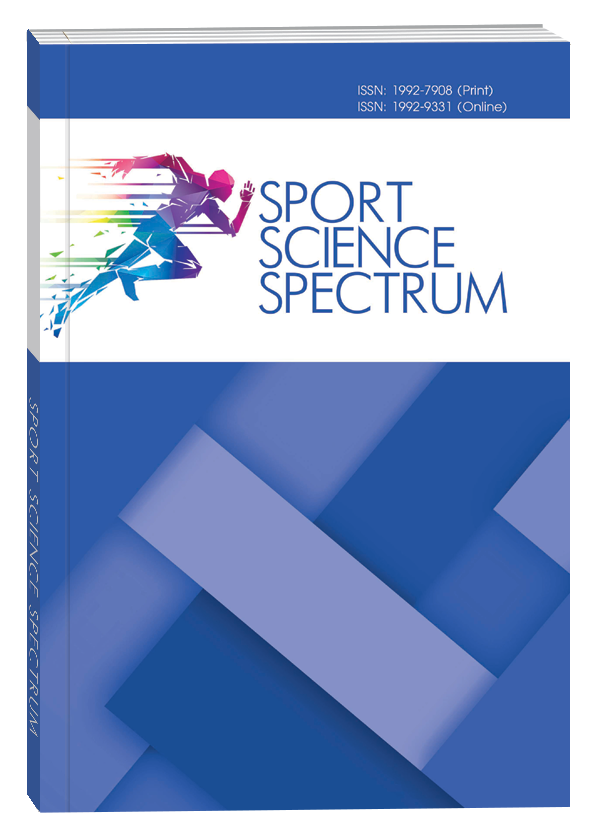FEATURES OF MODERN MOTION CAPTURE SYSTEMS
DOI:
https://doi.org/10.32782/spectrum/2024-2-3Keywords:
biomechanical analysis, human movement, modelling, sports technique, artificial intelligenceAbstract
Introduction. In the present era, high-precision quantitative biomechanical analysis of human motor actions is conducted by motion analysis systems that employ both standard digital cameras and specialized high-speed cameras. Nevertheless, no studies have yet examined the characteristics of contemporary motion capture systems from the perspectives of hardware and software. The objective of this study is to present an analytical overview of the features of modern motion capture systems. The methodology employed in this study comprises a theoretical analysis, a systematic and generalised synthesis of contemporary scientific and methodological literature, and an examination of Internet resources pertinent to the research problem. As a result, the wide variety of motion capture systems can be classified according to several criteria, including those that use specialized cameras and those that use standard cameras. In the domain of software, motion capture systems can be classified into two main categories: those that offer qualitative, visual analysis of video clips (such as the ability to merge up to nine video clips into a single video clip or to create a single image with multiple superimposed images of a movement), and those that provide quantitative parameters of motor action. Optical motion capture systems that employ specialized cameras with passive and active motion capture markers facilitate high-precision, detailed biomechanical analysis, with automatic marker identification based on professional software for 3D video motion analysis using up to 256 digital cameras with a resolution of up to 26 megapixels. The potential of motion analysis and modeling technologies, particularly those incorporating artificial intelligence, to automatically trace the coordinates of human body points was considered. As a conclusion of this study, the capabilities of modern motion analysis systems were analyzed depending on the hardware and software. Modern motion analysis systems allow obtaining quantitative and qualitative data on human movements in an objective, informative and real-time manner. The plethora of contemporary motion analysis technologies enables precise evaluation and qualitative examination of an athlete’s technique and motion patterns in both laboratory and field settings. The distinctive features of the BioVideo software for the biomechanical analysis of human motor actions through the use of video recording frames from a standard camera were presented.
References
Aurand Alexander M, Dufour Jonathan S, Marras William S. Accuracy map of an optical motion capture system with 42 or 21 cameras in a large
measurement volume. Journal of Biomechanics, Volume 58, 2017, Pages 237–240, ISSN 0021-9290, https://doi.org/10.1016/j.jbiomech.2017.05.006
Cao Z, Hidalgo G, Simon T, Wei SE, Sheikh Y. OpenPose: Realtime Multi-Person 2D Pose Estimation Using Part Affinity Fields. IEEE Trans Pattern Anal
Mach Intell. 2021;43(1):172–86. https://doi.org/10.1109/TPAMI.2019.2929257
Colyer S, Evans M, Cosker DP, Salo AIT. A Review of the Evolution of Vision-Based Motion Analysis and the Integration of Advanced Computer Vision
Methods Towards Developing a Markerless System. Sports Med Open. 2018;5(4):24. https://doi.org/10.1186/s40798-018-0139-y
Durve I, Ghuge S, Patil S, Kalbande D. Machine Learning Approach for Physiotherapy Assessment. 2019 International Conference on Advances in
Computing, Communication and Control (ICAC3); 2019. p. 1–5. https://doi.org/10.1109/icac347590.2019.90367
Fernández-González P, Koutsou A, Cuesta-Gómez A, Carratalá-Tejada M, Miangolarra-Page JC, Molina-Rueda F. Reliability of Kinovea® Software and
Agreement with a Three-Dimensional Motion System for Gait Analysis in Healthy Subjects. Sensors. 2020;20(11):3154. https://doi.org/10.3390/s20113154
Gyemi DL, Andrews DM, Jadischke R (2021) Three-dimensional video analysis of helmet-to-ground impacts in North American youth football. J Biomech
:110587. https://doi.org/10.1016/j.jbiomech.2021.110587
Gyemi, DL, Jadischke, R & Andrews, DM. Validation of a multi-camera videogrammetry approach for quantifying helmet impact velocity in football. Sports
Eng 26, 31 (2023). https://doi.org/10.1007/s12283-023-00423-7
Imas Y, Khmelnitska I, Khurtyk D, Korobeynikov G, Spivak M, Kovtun V. Neural network modelling of diagonal stride technique of highly qualified skiers
with hearing impairments. Journal of Physical Education and Sport ® (JPES), 18 Supplement issue 2, Art 181, pp. 1217 – 1222, 2018 online ISSN: 2247 – 806X;
p-ISSN: 2247 – 8051; ISSN – L = 2247 – 8051 © JPES, https://doi.org/10.7752/jpes.2018.s2181
Kashuba V, Khmelnitska I, Krupenya S. Biomechanical analysis of skilled female gymnasts’ technique in «round-off, flic-flac» type on the vault table.
Journal of Physical Education and Sport (JPES), 12(4). 2012, 431–435. https://doi.org/10.7752/jpes.2012.04064
Kashuba VA, Khmelnitskaya IV. Software for the Biomechanical Analysis of High Skilled Athlete’s Motor Actions. 4 th Intern. Scient. Conference on
Kinesiology «Science and Profession – Challenge for the Future». Opatija, Croatia. Sept. 7–11, 2005. Р. 855–857.
Khmelnitska I, Lisenchuk G, Leleka V, Boretska N, Krupenya S, Danko G. Biomechanical control of motor function of junior schoolchildren with hearing
impairment. Journal of Physical Education and Sport ® (JPES), Vol. 21 (4), Art 228, pp. 1806–1813, June 2021 online ISSN: 2247 – 806X; p-ISSN: 2247 – 8051;
ISSN – L = 2247 – 8051 © JPES. https://doi.org/10.7752/jpes.2021.04228
Kholodov S, Kashuba V, Khmelnitska V, Grygus I, Asauliuk I, Krupenya S. Model biomechanical characteristics of child’s walking during primary school
age. Journal of Physical Education and Sport ® (JPES), Vol 21 (Suppl. issue 5), Art 380 pp. 2857 – 2863, Oct 2021. online ISSN: 2247 – 806X; p-ISSN: 2247 –
; ISSN – L = 2247 – 8051 © JPES. https://DOI:10.7752/jpes.2021.s5380
Kidziński L, Yang B, Lee Hicks J, Rajagopal A, Delp SL, Schwartz MH, et al. Deep neural networks enable quantitative movement analysis using singlecamera
videos. Nat Commun. 2020;11(1):4054. https://doi.org/10.1038/s41467-020-17807-z
Kozak I, Zhyrnov O. Modern trends in biomechanical technologies in sports. Theory and Methods of Physical education and sports. 2023; 4: 20–26.
https://doi.org/10.32652/tmfvs.2023.4.20–26 [in Ukrainian]
Lisenchuk G, Khmelnitska I, Adyrkhaeva L, Krupenya S, Lysenchuk S. Diagnostics of human motor function in physical rehabilitation. Theory and
Methods of Physical education and sports. 2020; 1: 42–48. https://doi.org/10.32652/tmfvs.2020.1.42-48
Lyu Bin, Smith Lloyd, and Kensrud Jeff. A novel method to create long capture volumes for video tracking. Proceedings of the Institution of Mechanical
Engineers, Part P: Journal of Sports Engineering and Technology. https://doi.org/10.1177/17543371221099369
Moral-Munoz JA, Zhang W, Cobo MJ, Herrera-Viedma E, Kaber DB. Smartphone-based systems for physical rehabilitation applications: A systematic
review. Assist Technol. 2021;33(4):223–36. https://doi.org/10.1080/10400435.2019.1611676
Nor Adnan NM, Ab Patar MNA, Lee H, Yamamoto SI, Jong-Young L, Mahmud J. Biomechanical analysis using Kinovea for sports application. IOP Conf
Ser Mater Sci Eng. 2018;342:012097. https://doi.org/10.1088/1757-899x/342/1/012097
Nunes João F, Moreira Pedro M, Tavares João Manuel RS. Human Motion Analysis and Simulation Tools: A Survey: Handbook of Research on
Computational Simulation and Modelling in Engineering. 2016. Pages: 30. https://doi.org/10.4018/978-1-4666-8823-0.ch012
Schofield S, Bainbridge-Smith A, Green R. An improved semi-synthetic approach for creating visual-inertial odometry datasets. Graphical Models,
Volume 126, April 2023, 101172. https://doi.org/10.1016/j.gmod.2023.101172
Tack C. Artificial intelligence and machine learning applications in musculoskeletal physiotherapy. Musculoskelet Sci Pract. 2019; 39:164–9. https://
doi.org/10.1016/j.msksp.2018.11.012





